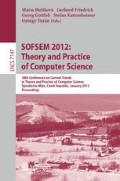Abstract
We consider the problem of computing all-pairs shortest paths in a directed graph with non-negative real weights assigned to vertices.
For an n×n 0 − 1 matrix C, let K C be the complete weighted graph on the rows of C where the weight of an edge between two rows is equal to their Hamming distance. Let MWT(C) be the weight of a minimum weight spanning tree of K C .
We show that the all-pairs shortest path problem for a directed graph G on n vertices with non-negative real weights and adjacency matrix A G can be solved by a combinatorial randomized algorithm in time
As a corollary, we conclude that the transitive closure of a directed graph G can be computed by a combinatorial randomized algorithm in the aforementioned time.
We also conclude that the all-pairs shortest path problem for vertex-weighted uniform disk graphs induced by point sets of bounded density within a unit square can be solved in time \(\widetilde{O}(n^{2.75})\).
Access this chapter
Tax calculation will be finalised at checkout
Purchases are for personal use only
Preview
Unable to display preview. Download preview PDF.
References
Aho, A.V., Hopcroft, J.E., Ullman, J.D.: The Design and Analysis of Computer Algorithms. Addison-Wesley, Reading (1974)
Alon, N., Naor, M.: Derandomization, Witnesses for Boolean Matrix Multiplication and Construction of Perfect hash functions. Algorithmica 16, 434–449 (1996)
Alon, N., Galil, Z., Margalit, O.: On the exponent of all pairs shortest path problem. J. Comput. System Sci. 54, 25–51 (1997)
Bansal, N., Williams, R.: Regularity Lemmas and Combinatorial Algorithms. In: Proc. of 50th IEEE Symposium on Foundations on Computer Science, Atlanta (2009)
Björklund, A., Lingas, A.: Fast Boolean Matrix Multiplication for Highly Clustered Data. In: Dehne, F., Sack, J.-R., Tamassia, R. (eds.) WADS 2001. LNCS, vol. 2125, pp. 258–263. Springer, Heidelberg (2001)
Borodin, A., Ostrovsky, R., Rabani, Y.: Subquadratic Approximation Algorithms For Clustering Problems in High Dimensional Spaces. In: Proceedings of the 31st ACM Symposium on Theory of Computing (1999)
Cameron, P.J.: Combinatorics. Cambridge University Press (1994)
Chan, T.M.: More algorithms for all-pairs shortest paths in weighted graphs. SIAM J. Comput. 39(5), 2075–2089; preliminary version in proc. STOC 2007, pp. 590–598 (2007)
Chan, T.M.: All-pairs shortest paths with real weights in O(n 3/logn) time. Algorithmica 41, 330–337 (2008)
Coppersmith, D., Winograd, S.: Matrix Multiplication via Arithmetic Progressions. J. of Symbolic Computation 9, 251–280 (1990)
Fürer, M., Kasiviswanathan, S.P.: Approximate Distance Queries in Disk Graphs. In: Erlebach, T., Kaklamanis, C. (eds.) WAOA 2006. LNCS, vol. 4368, pp. 174–187. Springer, Heidelberg (2007)
Galil, Z., Margalit, O.: Witnesses for Boolean Matrix Multiplication and Shortest Paths. Journal of Complexity, 417–426 (1993)
Gąsieniec, L., Lingas, A.: An Improved Bound on Boolean Matrix Multiplication for Highly Clustered Data. In: Dehne, F., Sack, J.-R., Smid, M. (eds.) WADS 2003. LNCS, vol. 2748, pp. 329–339. Springer, Heidelberg (2003)
Huang, X., Pan, V.Y.: Fast rectangular matrix multiplications and applications. Journal of Complexity 14(2), 257–299 (1998)
Indyk, P.: High-dimensional computational geometry. PhD dissertation, Standford University (2000)
Indyk, P., Motwani, R.: Approximate Nearest Neighbors: Towards Removing the Curse of Dimensionality. In: Proceedings of the 30th ACM Symposium on Theory of Computing (1998)
Indyk, P., Schmidt, S.E., Thorup, M.: On reducing approximate mst to closest pair problems in high dimensions (1999) (manuscript)
Karp, R.M., Steele, J.M.: Probabilistic analysis of heuristics. In: Lawler, E.L., Lenstra, J.K., Rinnooy Kan, A.H.G., Shmoys, D.B. (eds.) The Traveling Salesman Problem: A Guided Tour of Combinatorial Optimization, ch. 6, pp. 181–205. John Wiley & Sons Ltd. (1985)
Kushilevitz, E., Ostrovsky, E., Rabani, Y.: Efficient search for approximate nearest neighbor in high dimensional spaces. SIAM J. Comput. 30(2), 457–474; Preliminary version in Proc. 30th STOC (1989)
Lingas, A.: A Geometric Approach to Boolean Matrix Multiplication. In: Bose, P., Morin, P. (eds.) ISAAC 2002. LNCS, vol. 2518, pp. 501–510. Springer, Heidelberg (2002)
Munro, J.I.: Efficient determination of the transitive closure of a directed graph. Information Processing Letters 1(2), 56–58 (1971)
Rytter, W.: Fast recognition of pushdown automaton and context-free languages. Information and Control 67(1-3), 12–22 (1985)
Seidel, R.: On the All-Pairs-Shortest-Path Problem. In: Proc. 24th ACM STOC, pp. 745–749 (1992)
Vassilevska, V., Williams, R.: Subcubic Equivalences Between Path, Matrix, and Triangle Problems. In: Proceedings 51st Annual IEEE Symposium on Foundations of Computer Science, FOCS (2010)
Yuster, R.: Efficient algorithms on sets of permutations, dominance, and real-weighted APSP. In: Proc. of the 20th ACM-SIAM Symposium on Discrete Algorithms, pp. 950–957 (2009)
Zwick, U.: All pairs shortest paths using bridging rectangular matrix multiplication. Journal of the ACM 49(3), 289–317 (2002)
Zwick, U.: Exact and Approximate Distances in Graphs - A survey. In: Meyer auf der Heide, F. (ed.) ESA 2001. LNCS, vol. 2161, pp. 33–48. Springer, Heidelberg (2001)
Author information
Authors and Affiliations
Editor information
Editors and Affiliations
Rights and permissions
Copyright information
© 2012 Springer-Verlag Berlin Heidelberg
About this paper
Cite this paper
Lingas, A., Sledneu, D. (2012). A Combinatorial Algorithm for All-Pairs Shortest Paths in Directed Vertex-Weighted Graphs with Applications to Disc Graphs. In: Bieliková, M., Friedrich, G., Gottlob, G., Katzenbeisser, S., Turán, G. (eds) SOFSEM 2012: Theory and Practice of Computer Science. SOFSEM 2012. Lecture Notes in Computer Science, vol 7147. Springer, Berlin, Heidelberg. https://doi.org/10.1007/978-3-642-27660-6_31
Download citation
DOI: https://doi.org/10.1007/978-3-642-27660-6_31
Publisher Name: Springer, Berlin, Heidelberg
Print ISBN: 978-3-642-27659-0
Online ISBN: 978-3-642-27660-6
eBook Packages: Computer ScienceComputer Science (R0)

